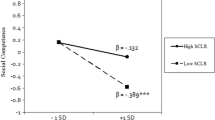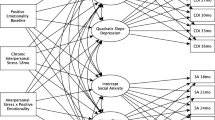Abstract
Depressive symptoms are considered to have evolutionary social functions to reduce social risks with peers and family members. However, social processes and their relationship to depressive symptoms have been understudied in adolescent boys. Low engagement in social contexts may predict depressive symptoms in adolescent boys, as it may signify efforts to reduce social risks. To address these issues, this study focused on 160 boys at risk for affective problems based on low socioeconomic status. We evaluated how behavioral and physiological engagement in peer and family contexts, respectively, in late childhood predicted depressive symptoms at age 12 and age 15. Social withdrawal was measured across late childhood (ages 9–12) in a camp setting using a latent variable of teacher ratings of withdrawn behavior, peer nominations of withdrawn behavior, and camp counselor ratings of withdrawn behavior. Physiological reactivity was measured during a provocative parent–child conversation using respiratory sinus arrhythmia (RSA) at age 12. Social withdrawal in late childhood predicted depressive symptoms at age 12. The combination of high levels of social withdrawal with peers from ages 9–12 and low RSA reactivity with a parent at age 12 predicted higher depressive symptoms at age 15. Withdrawal in multiple social contexts may place boys at risk for depressive symptoms during the vulnerable period of adolescence.



Similar content being viewed by others
References
Achenbach, T. M. (1992). Manual for the child behavior checklist and revised child behavior profile. Burlington: University of Vermont, Department of Psychiatry.
Allen, N. B., & Badcock, P. B. T. (2003). The social risk hypothesis of depressed mood: Evolutionary, psychosocial, and neurobiological perspectives. Psychological Bulletin, 129, 887–913.
Bauer, D. J., & Curran, P. J. (2005). Probing interactions in fixed and multilevel regression: Inferential and graphical techniques. Multivariate Behavioral Research, 40, 373–400.
Berntson, G. G., Bigger, J. T., Jr, Eckberg, D. L., Grossman, P., Kaufmann, P. G., Malik, M., et al. (1997). Heart rate variability: origins, methods, and interpretive caveats. Psychophysiology, 34, 623–648.
Burke, H. M., Davis, M. C., Otte, C., & Mohr, D. C. (2005). Depression and cortisol responses to psychological stress: A meta-analysis. Psychoneuroendocrinology, 30, 846–856.
Calkins, S. D., Blandon, A. Y., Williford, A. P., & Keane, S. P. (2007a). Biological, behavioral, and relationshipal levels of resilience in the context of risk for early childhood behavior problems. Development and Psychopathology, 19, 675–700.
Calkins, S. D., Graziano, P. A., & Keane, S. P. (2007b). Cardiac vagal regulation differentiates among children at risk for behavior problems. Biological Psychology, 74, 144–153.
Calkins, S. D., & Keane, S. P. (2004). Cardiac vagal regulation across the preschool period: Stability, continuity, and implications for childhood adjustment. Developmental Psychobiology, 31, 125–135.
Cicchetti, D., & Toth, S. L. (1998). The development of depression in children and adolescents. American Psychologist, 53, 221–240.
Clark, L. A., & Watson, D. (1991). Tripartite model of anxiety and depression: Psychometric evidence and taxonomic implications. Journal of Abnormal Psychology, 1000, 316–336.
Compas, B. E., Connor-Smith, J., & Jaser, S. S. (2004). Temperament, stress reactivity, and coping: Implications for depression in childhood and adolescence. Journal of Clinical Child and Adolescent Psychology, 33, 21–31.
Coplan, R. J., Prakash, K., O’Neil, K., & Armer, M. (2004). Do you “want” to play? Distinguishing between conflicted-shyness and social disinterest in early childhood. Developmental Psychology, 40, 244–258.
Davey, C. G., Yucel, M., & Allen, N. B. (2008). The emergence of depression in adolescence: Development of prefrontal cortex and the representation of reward. Neuroscience and Biobehavioral Reviews, 32, 1–19.
Durbin, C. E., Klein, D. N., Hayden, E. P., Buckley, M. E., & Moerk, K. C. (2005). Temperamental emotionality in preschoolers and parental mood disorders. Journal of Abnormal Psychology, 114, 28–37.
El-Sheikh, M. (2005). Stability of respiratory sinus arrhythmia in children and young adolescents: A longitudinal examination. Developmental Psychobiology, 46, 66–74.
Forbes, E. E., & Dahl, R. E. (2005). Neural systems of positive affect: Relevance to understanding child and adolescent depression? Developmental Psychopathology, 17, 827–850.
Forbes, E. E., Shaw, D. S., & Dahl, R. E. (2007). Alterations in reward-related decision making in boys with recent and future depression. Biological Psychiatry, 61, 633–639.
Gentzler, A. L., Santucci, A. K., Kovacs, M., & Fox, N. (2009). Respiratory sinus arrhythmia reactivity predicts emotion regulation and depressive symptoms in at-risk and control children. Biological Psychology, 82, 156–163.
Gotlib, I. H., Hamilton, J. P., Cooney, R. E., Singh, M. K., Henry, M. L., & Joorman, J. (2010). Neural processing of reward and loss in girls at risk for major depression. Archives of General Psychiatry, 67, 380–387.
Hankin, B. L., Abramson, L., Moffitt, T. E., Silva, P., McGee, R., & Angell, K. E. (1998). Development of depression from preadolescence to young adulthood: Emerging gender differences in a 10-year longitudinal study. Journal of Abnormal Psychology, 107, 128–140.
Hasler, G., Drevets, W. C., Manji, H. K., & Charney, D. S. (2004). Discovering endophenotypes for major depression. Neuropsychopharmocology, 29, 1765–1781.
Hetherington, E. M., Clingempeel, W. G., Anderson, E. R., Deal, J. E., Stanley Hagan, M., Hollier, A. E., et al. (1992). Coping with marital transitions: A family systems perspective. Monographs of the Society for Research in Child Development, 57(12–3), 227.
Hollingshead, A. B. (1975). Four factor index of social status. Yale University, Department of Sociology (Unpublished manuscript).
Joiner, T. E., Lewinsohn, P. M., & Seeley, J. R. (2002). The core of loneliness: Lack of pleasurable engagement—more so than painful disconnection—predicts social impairment, depression onset, and recovery from depressive disorders among adolescents. Journal of Personality Assessment, 79, 472–491.
Kaufman, J., Birmaher, B., Brent, D., Rao, U., Flynn, C., & Moreci, P. (1997). Schedule for affective disorders and schizophrenia for school-age children-present and lifetime version (K-SADS-PL): Initial reliability and validity data. Journal of American Academy of Child and Adolescent Psychiatry, 36, 980–988.
Keenan, K., & Hipwell, A. (2005). Preadolescent cues to understanding depression in girls. Clinical Child and Family Psychology Review, 8, 89–105.
Keenan, K., & Shaw, D. S. (1994). The development of aggression in toddlers: A study of low income families. Journal of Abnormal Child Psychology, 22, 53–77.
Kercher, A. J., Rapee, R. M., & Schniering, C. A. (2009). Neuroticism, life events, and negative thoughts in the development of depression in adolescent girls. Journal of Abnormal Child Psychology, 37, 903–915.
Kline, R. B. (2005). Principles and practice of structural equation modeling. New York: Guilford Press.
Kovacs, M. (1978). Children’s depression inventory (CDI). University of Pittsburgh (Unpublished manuscript).
Lewinsohn, P. M., Clarke, G. N., Seeley, J. R., & Rohde, P. (1994). Major depression in community adolescents: Age at onset, episode duration, and time to recurrence. Journal of the American Academy of Child and Adolescent Psychiatry, 33, 809–818.
Lewinsohn, P. M., Solomon, A., Seeley, J. R., & Zeiss, A. (2000). Clinical implications of “subthreshold” depressive symptoms. Journal of Abnormal Psychology, 109, 345–351.
Morgan, J. K., Olino, T. M., McMakin, D. L., Ryan, N. D., & Forbes, E. E. (in press). Neural response to reward as a predictor of increases in depressive symptoms in adolescence. Neurobiology of Disease. [Epub ahead of print].
Morris, A. S., Silk, J. S., Steinberg, L., Myers, S. S., & Robinson, L. R. (2007). The role of the family context in the development of emotion regulation. Social Development, 16(2), 361–388.
Muthen, L. & Muthen, B. (1998–2010). Mplus: User’s guide 6.0. Los Angeles, CA: Muthen & Muthen.
Reid, J. B., Fetrow, R. A., & Mayne, T. (1991). LIFT playground observer Impressions. Oregon Social Learning Center, (Unpublished measure).
Rose, A. J., & Rudolph, K. D. (2006). A review of sex differences in peer relationship processes: Potential trade-offs for the emotional and behavioral development of girls and boys. Psychological Bulletin, 132, 98–131.
Rottenberg, J., Clift, A., Bolden, S., & Saloman, K. (2007). RSA fluctuation in major depressive disorder. Psychophysiology, 44, 450–458.
Rubin, K. H., Coplan, R. J., & Bowker, J. C. (2009). Social withdrawal in childhood. Annual Review of Psychology, 60, 141–171.
Rubin, K. H., Coplan, R. J., Fox, N. A., & Calkins, S. D. (1995). Emotionality, emotion regulation, and preschoolers’ social adaptation. Development and Psychopathology, 7, 49–62.
Santucci, A. K., Silk, J. S., Shaw, D. S., Gentzler, A., Fox, N. A., & Kovacs, M. (2008). Vagal tone and temperament as predictors of emotion regulation strategies in young children. Developmental Psychobiology, 50, 205–216.
Shannon, K. E., Beauchaine, T. P., Brenner, S. L., Neuhaus, E., & Gatzke-Kopp, L. (2007). Familial and temperamental predictors of resilience in children at risk for conduct disorder and depression. Development and Psychopathology, 19, 701–727.
Silk, J., Dahl, R. E., Ryan, N. D., Forbes, E. E., Axelson, D. A., Birmaher, B., et al. (2007). Pupillary reactivity to emotional information in child and adolescent depression: Links to clinical and ecological measures. American Journal of Psychiatry, 164, 1873–1880.
Stice, E., Presnell, K., & Bearman, S. K. (2001). Relation of early menarche to depression, eating disorders, substance abuse, and comorbid psychopathology among adolescent girls. Developmental Psychology, 37, 608–619.
Trentacosta, C. J., & Shaw, D. S. (2009). Emotional self-regulation, peer rejection, and antisocial behavior: Developmental associations from early childhood to early adolescence. Journal of Applied Developmental Psychology, 30, 356–365.
Vanderbilt, E., & Shaw, D. (2007). Psychosocial, cognitive, and physiological protective factors and the absence of antisocial behavior in a longitudinal study of low income boys. (Unpublished manuscript).
Wadsworth, M. E., & Achenbach, T. M. (2005). Explaining the link between low socioeconomic status and psychopathology: Testing two mechanisms of the social causation hypothesis. Journal of Consulting and Clinical Psychology, 73, 1146–1153.
Weber, E. J. M., Molenaar, P. C. M., & van der Molen, M. W. (1988). PSPAT: A program for spectral analysis of point events including a test for stationarity. In L. J. M. Mulder, F. J. Maarse, W. P. B. Sjouw, & A. E. Akkerman (Eds.), Computers in psychology: Applications in education, research, and psychodiagnostics. Amsterdam: Swets, Zeitlinger.
Acknowledgments
This research was funded by Grants MH50907 and MH46925 from the National Institute of Mental Health. We thank the staff and families of the Pitt Mother and Child Project for making this research possible. Correspondence should be addressed to Judith K. Morgan, 219 Loeffler Building, University of Pittsburgh, Pittsburgh, Pennsylvania, 15232.
Author information
Authors and Affiliations
Corresponding author
Rights and permissions
About this article
Cite this article
Morgan, J.K., Shaw, D.S. & Forbes, E.E. Physiological and Behavioral Engagement in Social Contexts as Predictors of Adolescent Depressive Symptoms. J Youth Adolescence 42, 1117–1127 (2013). https://doi.org/10.1007/s10964-012-9815-2
Received:
Accepted:
Published:
Issue Date:
DOI: https://doi.org/10.1007/s10964-012-9815-2




